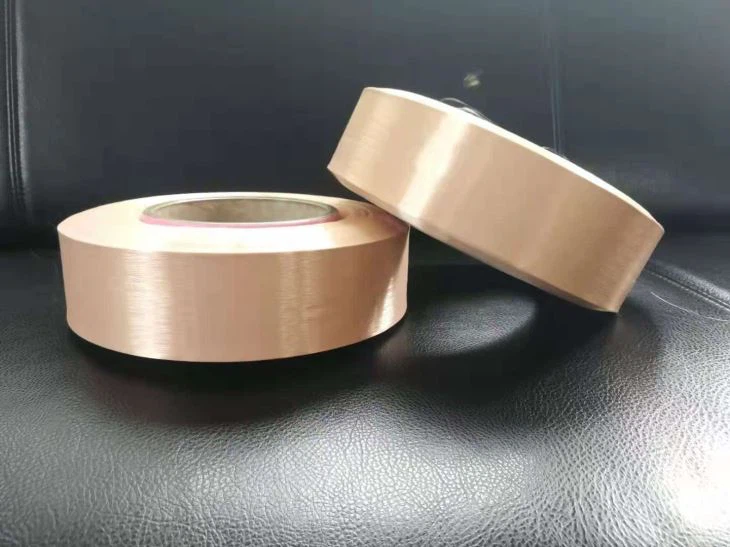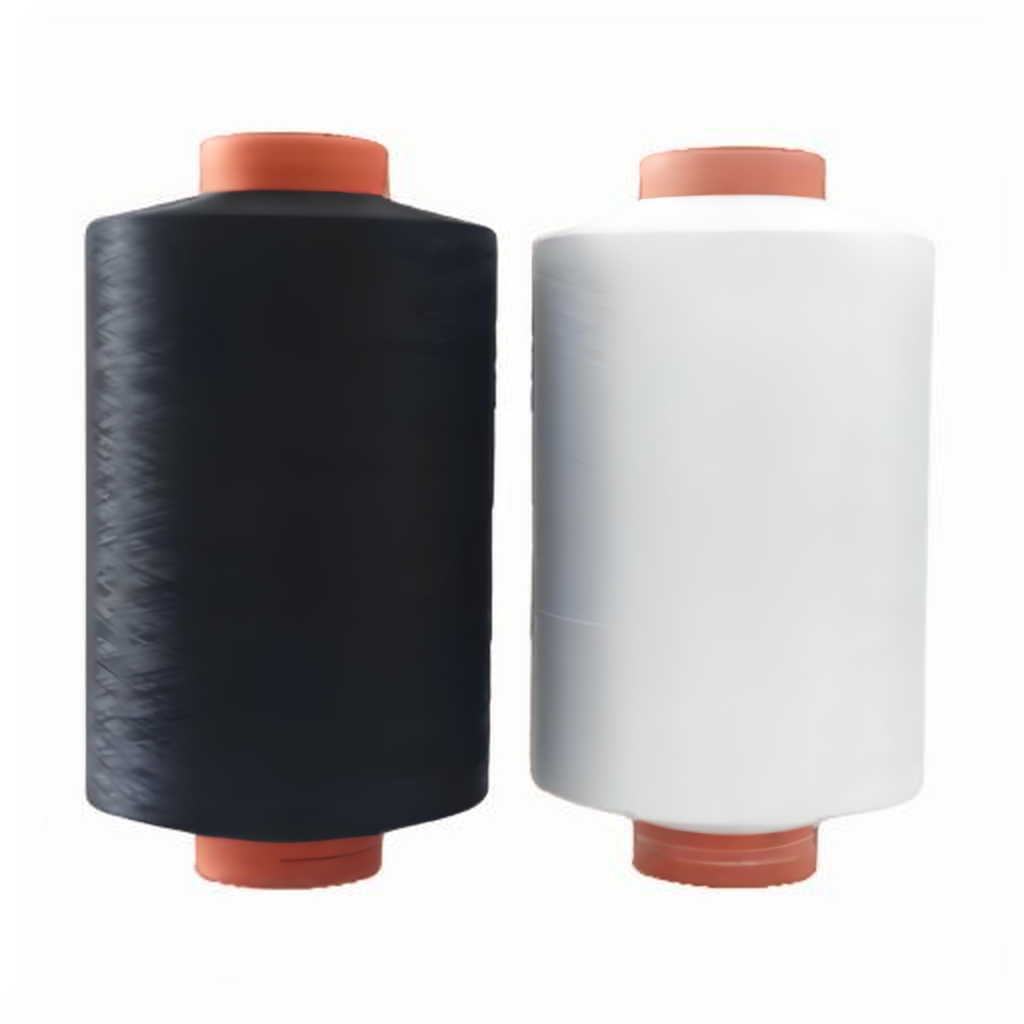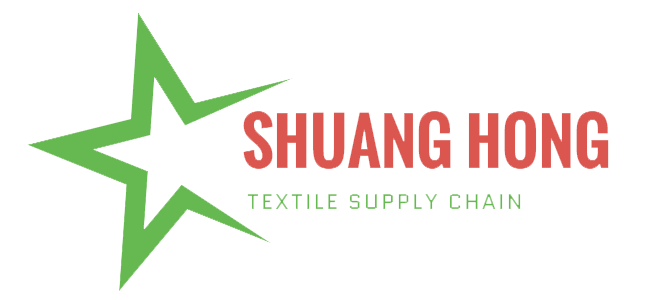
Development And Performance Of Polyester Filament - China Yarns Manufacturer And Supplier
An essential synthetic fibre, polyester filament is crucial in the contemporary textile sector. Polyester filament has progressively displaced conventional fibre materials and grown to be a major raw material for textile manufacture since its initial commercial production in the late 1940s because to its great physical qualities and broad application areas. The manufacturing method and performance of polyester filament have also seen major growth and improvement in line with changes in market demand and ongoing scientific and technological advances.

Polyester filament sewing thread
Polyester Filament Development Background
One may find the origins of polyester filament in the 40s. American scientists first effectively synthesised polyester in 1946, and the textile business took fast notice of this novel fibre. The manufacturing technique of polyester filament developed gradually in the 1950s and started to be pushed and used commercially. Early polyester filament was mostly used to create everyday textiles, like clothes and bedding, and its market was mostly focused in wealthy nations such Europe and the United States.
As we enter the 1970s, polyester filament application areas and manufacturing techniques have become greatly broad. The manufacturing method of polyester filament has progressively evolved from the first basic spinning technology to a production technology with more efficiency and more complicated control as science and technology have improved. Polyester filament started to be extensively utilised in athletics, home textiles and industrial materials during this era. Furthermore under increasing focus is the functional improvement of polyester filament. For instance, the arrival of functional polyester filaments including anti-wrinkle, antimicrobial, moisture absorption and sweating has given textile goods greater value.
Starting the twenty-first century, polyester filament’s manufacturing technology has been steadily improved, particularly in relation to high-performance polyester filament research and development. For instance, recently introduced items like ecologically friendly recycled polyester filament and composite functional polyester filament and ultra-fine denier polyester filament have progressively found their way into the market. These novel polyester filaments satisfy the dual needs of current customers for textile performance and environmental conservation as they not only have stronger strength and flexibility but also improved durability and utility.
Polyester filament main performance metrics
Strength, flexibility, abrasion resistance, light resistance and hygroscopicity define polyester filament’s primary performance criteria. These performance criteria directly influence the practical applications’ performance and usage impact of polyester filament.
The strength of polyester filament is among its most crucial performance metrics first of all. High tensile strength and breaking strength of polyester filament help it to resist big weights and forces in textiles. Industrial textiles, sports equipment, etc. are only a few of the applications for high-strength polyester filament in sectors needing great strength and wear resistance.
Second, one more crucial quality of polyester filament is flexibility. Excellent elasticity of polyester filament allows it to be efficiently restored to prevent distortion and relaxation. This quality gives polyester filament exceptional shape retention and a pleasant wearing experience, which helps it to perform effectively in the manufacturing of elastic textiles, sportswear and other sectors.
An additional crucial metric for assessing polyester filament performance is wear resistance. Over extensive usage, polyester filament may preserve the integrity and look of the fibre and has decent wear resistance. This makes polyester filament especially ideal for manufacturing carpets, work clothing and other goods needing wear-throughability.
Light resistance is the capacity of polyester filament to retain its physical characteristics and colour under light circumstances. Good light resistance and strong UV ray resistance in polyester filament help to prevent ageing and fade in sunshine. Outdoor goods like sunshade cloth, outdoor furniture, etc. need for polyester filament with great light resistance.
Though it is not the primary performance metric for polyester filament, hygroscopicity is still a factor of great relevance in specific use situations. Since polyester filament has quite low hygroscopicity, sportswear is often made from various fibres to enhance the impact of moisture absorption and sweat.
Polyester filament’s application domains
Polyester filament finds extensive use in numerous sectors, including household, industry, apparel, and vehicle. Polyester filament’s great strength, flexibility, and wear resistance have made it the favoured raw material in the garment business for creating all types of apparel. With its great performance and durability, polyester filament satisfies customers’ different demands for apparel from everyday shirts and skirts to sports equipment and outdoor clothes.
Polyester filament is extensively utilised in the home sector for bedding, curtains, carpets, etc. Polyester filament’s durability and simplicity of cleaning help these house goods to resist regular cleaning and long-term usage. Furthermore helping household goods to keep excellent look and comfort are the colour stability and wrinkle resistance of polyester filament.
Fleece Blanket Manufacturer Utilization of Polyester Filament
Fleece blanket manufacturer are a prime example of how polyester filament’s properties are leveraged in the home textiles industry. These manufacturers rely on polyester filament for its exceptional strength and flexibility, which contribute to the creation of warm, comfortable, and durable blankets. The high tensile strength ensures that the blankets can withstand regular use and washing without losing their shape or integrity. Moreover, the flexibility of polyester filament allows for the production of blankets with a soft, pliable texture that is pleasant to the touch. The durability and colorfastness of polyester filament are particularly beneficial for fleece blankets, as they help maintain the product’s appearance over time and through multiple wash cycles. By integrating polyester filament into their products, fleece blanket manufacturers can offer consumers high-quality blankets that are both practical and aesthetically pleasing.
Polyester filament has applications in the industrial sector covering technical textiles, filter materials, seat belts, etc. Polyester filament’s great strength and wear resistance help it to be steady performance and extended service life as well as to fit different demanding working conditions. Particularly in protective gear and seat belts, polyester filament’s great strength guarantees users’ safety rather successfully.
One other significant use area for polyester filament is the automobile sector. Car seats, interior décor, carpets, and other items all utilise polyester filament extensively. Its great light resistance and durability help these components to keep good look and function throughout long-term usage, thus enhancing the whole quality and comfort of the vehicle.
Polyester filament dyeing and post-processing technologies
The ultimate look and performance of polyester filament depend much on its dyeing and post-processing technologies. Usually coloured with dispersion dyes, polyester filament may be obtained brilliant and long-lasting by high temperature and high pressure penetrating into polyester fibres. Factors like temperature, duration, and dye concentration must be under control throughout the dyeing process if we want to raise the uniformity and colour fastness of dyeing. Furthermore greatly enhancing its effectiveness and breadth of use are post-treatment technologies of polyester filaments include anti-wrinkle finishing, waterproof finishing, and antibacterial finishing.

Fully drawn polyester filament FDY
In summary
Polyester filament’s great performance and broad application areas have helped it to progressively become a major component of the contemporary textile business since its introduction in the middle of the 20th century. From the first basic performance to today’s high-performance and functional goods, the evolution of polyester filament has seen the advance of science and technology and the variations in market demand.
Its great qualities—high strength, flexibility, abrasion resistance, and light resistance—have made it extensively employed in various disciplines, including industry, apparel, home furnishings, and cars. Furthermore giving great assistance for the performance enhancement and application development of polyester filaments is the ongoing optimisation of dyeing and post-treatment technologies. The manufacture and use of polyester filaments will bring in new innovations and difficulties as science and technology advance and environmental protection criteria become better. This will help the textile sector grow.
Feature Product
-
 DTY 100D/144F Polyester Yarn
DTY 100D/144F Polyester YarnDTY 100D/144F Polyester Yarn: The Ultimate Guid...
-
 DTY 100D/96F Polyester Yarn
DTY 100D/96F Polyester YarnDTY 100D/96F Polyester Yarn: The Soft, Stable S...
-
 DTY 75D/144F SIM Polyester Yarn
DTY 75D/144F SIM Polyester YarnDTY 75D/144F SIM Polyester Yarn: A Top Choice f...

